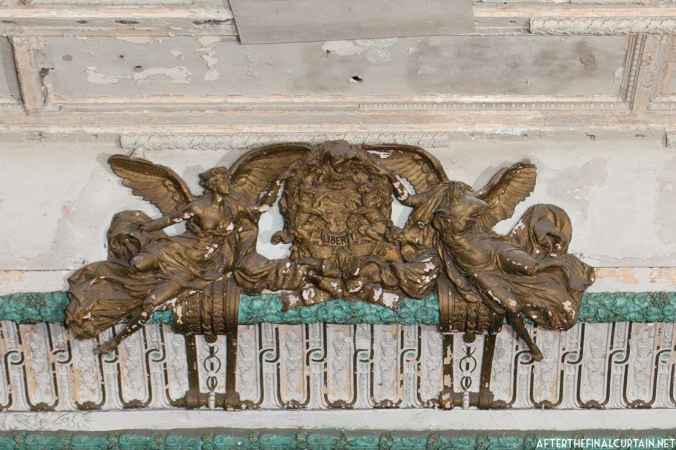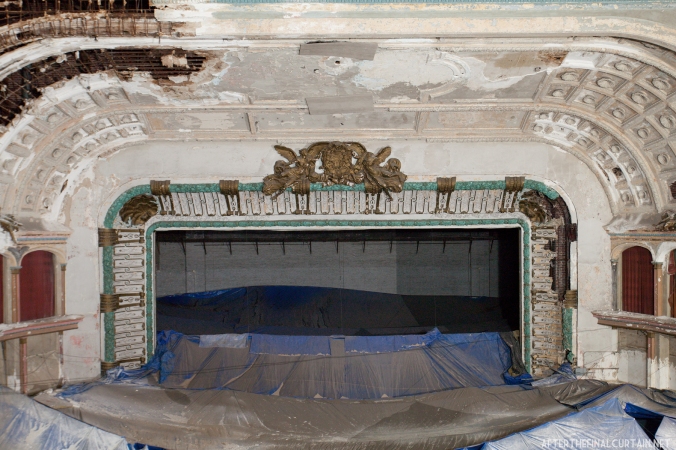Post 2 in the Snapshot Series – Occasionally in my travels I come across a theater that I can’t find a lot of information on, or that I only have a chance to photograph for an hour or two. They’re still beautiful and fascinating, so they definitely have a place on After the Final Curtain.
Philadelphia’s Metropolitan Opera House opened on November 17, 1908 as the Philadelphia Opera House. The 3,482 seat theater was built by architect William H. McElfatrick for Oscar Hammerstein, the grandfather of Oscar Hammerstein II, the famous musical theater lyricist. However, Hammerstein fell into debt and was forced to sell the opera house to one of his competitors, the Metropolitan Opera of New York City, after only two years.

The plasterwork at the top of the proscenium arch depicts two angels surrounding the state seal of Pennsylvania. In the center is the word Liberty, part of the state’s motto.
The MET occupied the building until 1920, after which several opera companies used it until the mid 1930s. Over the years, the building went through many different uses, including as a movie theater in the late 1920’s, a ballroom in the late 1930’s and a sports arena in the 1940’s. The theater was then purchased by a reverend in 1954, who turned it into a church. The Met Church was very popular, often filling the mezzanine and the upper balcony. Over time the church’s congregation decreased, the owners were no longer able to keep up with repairs, and the building began to deteriorate.
In 1988, the church was forced to close due to serious disrepair. It remained abandoned until 1995 when it was purchased by the Reverend Mark Hatcher, Jr. and the Holy Ghost Headquarters, another church. The Holy Ghost have repaired some of the building, but due to the condition of the walls and the balcony level ceiling, they were forced to place a reinforced tarp between the balcony and main levels. Reverend Hatcher has attempted to raise money to restore the building, and in 2012 it was announced that the church had teamed with Philadelphia developer Eric Blumenfeld to develop a plan to restore the theater. The Met is currently undergoing a 56 million dollar renovation and will reopen in December 2018.
© Matthew Lambros and After the Final Curtain, 2013. Unauthorized use and/or duplication of this material without express and written permission from this blog’s author and/or owner is strictly prohibited. Excerpts and links may be used, provided that full and clear credit is given to Matthew Lambros and After the Final Curtain with appropriate and specific direction to the original content.



Love the plaster work.
Please God don’t them restore this as a church.
I think the plan is going to be a mixed use venue. Church, Concert hall, etc.
Good. I hate to see these places turned into the next strip mall church.
More often than not becoming a church is the best thing that can happen to these theaters. They usually keep them in pretty good shape.
Hi.
Anything back stage?
Hi Steve – The bottom half of the stage area is in use, so I’m pretty sure it’s been cleaned out.
lovely, like a giant open clam. Proscenium sounds like such a dirty word – maybe a forbidden body part of a clam. .. . . Nice post!
Reblogged this on ladyauspicious.
The Met has a cameo in the Bruce Willis movie “12 Monkeys”. See http://movie-tourist.blogspot.com/2013/07/12-monkeys-1995.html
Cross your fingers for us. We saw an experimental dance production in the ghost of the Met back at the 2009 Hidden City festival.
http://hiddencityphila.org/2013/10/the-mets-next-revival/
P.S. Because of its excellent acoustics, the Met was long used as a recording venue for the Philadelphia Orchestra.
So weird that they’ve divided the room vertically … I didn’t realize that at first. Hard to imagine the lower half looking acceptable for anyone with a tarp for a ceiling.
I agree Chris. I’d be worried about plaster-work falling through the tarp and injuring someone during a service. I had heard that the tarp was reinforced, but I never confirmed that. Here’s what the lower level looked like:
I love this place, Good job HGH.
Pingback: Snapshot: Hollywood Theatre – After the Final Curtain
As a child my mother took me there but I never dream that one day I would have a chance to attend event within my life time. I pray that one day soon I waking in dreams of many.
Thank you so much bring the Arts to the Met PHILADELPHIA
Laura Elam
Ktip with Laura
Now completely restored!!!! Yay!!!
Is it really restored? I worked with Thea Jones in the fifties and dreamed of seeing the beautiful plasterwork restored.
But also the place is full of history which needs to be recorded.
It’s not my favorite restoration, but it’s restored and was reopened pre-covid.
Did The Met Opera House re-open in Philly ?